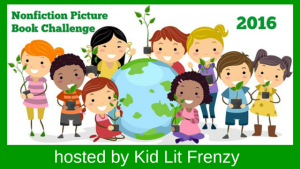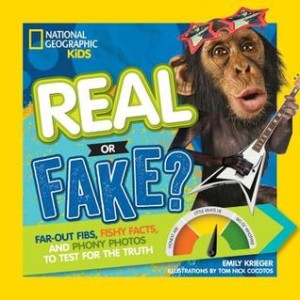Nonfiction Wednesday
Nonfiction Picture Book Wednesday is hosted by Kid Lit Frenzy and was started to help promote the reading of nonfiction texts. Most Wednesdays, we will be participating and will review a nonfiction text (though it may not always be a picture book).
Be sure to visit Kid Lit Frenzy and see what other nonfiction books are shared this week!
Reeal or Fake? Far-Out Fibs, Fishy Facts, and Phony Photos to Test for the Truth
Author: Emily Krieger
Illustrator: Tom Nick Cocotos
Published May 10th, 2016 by National Geographic Children’s Books
Goodreads Summary: Can you tell the truth from a tall tale? Spot a phony photo a mile away? Figure out a fib in five second flat? Then Real or Fake? is the book for you! Put your amateur detective skills to work in this fun and wacky book and see if the truth triumphs as you encounter suspicious stories, fishy facts, lying lists, and more. You’ll even play interactive games that will leave you second-guessing everything you’ve ever read. Complete with awesome photos and hilarious collage art, this is one book that you have to read to believe . . . or disbelieve.
Kellee’s Review: This National Geographic text was really fascinating! I loved reading the little synopsis then trying to guess if the scenario is true or not. Although some were quite obvious to me, I best many of them will trick students! As a teacher, I also think this book will be a great addition to research units because it will begin a discussion about reliability and validity.
Ricki’s Review: This book would be a fabulous choice for a road trip. I can imagine reading the pages aloud to my kids as they guessed “Real!” or “Fake!” I also like how the facts aren’t all silly and pointless. There is a lot of good learning that happens in these pages–and as an adult, the facts weren’t obvious to me, either, so I would have fun on the car ride, too! I completely agree with Kellee’s smart suggestion that this would be a great book to introduce reliability and validity. With the political campaigning and the sharing of memes that are completely false (from both sides), I have been thinking about reliability and validity a lot lately!
Teachers’ Tools for Navigation: In addition to being an instant favorite in classrooms, Real or Fake? will definitely make anyone who reads it want to either research some of the real/fake information shared (Was Teddy Roosevelt shot but continued with his speech? and Did a chimp’s song became #19 on the European billboard charts?) or want to go research things they think they know! Real or Fake? will be a great book to use when talking about research and would be a fun introduction to Snopes.
We Flagged: “Plants make music: Real or Fake? It may sound crazy, but plants can play tunes. A new device converts electrical currents moving across a plant’s surface into synthesizer sound in real time. (Though the sound of the converted currents may not be music to your ears.) The device works in much the same way a lit-detector test does, only the probes are placed on leaves instead of on skin and the currents are translated into audio. What does this ‘music’ tell us about the secret life of plants? The inventors aren’t quite sure yet. They are, however, hoping the ‘biofeedback’ will eventually be revealing an help us learn more about the natural world. In the meantime, rest easy knowing that one day soon your houseplants could play a tune: An online fund-raising campaign to make the device available to people interested in purchasing it has reached its goal.”
Real! With its far-out sounds, the MIDI-sprout (‘MIDI’ stands for ‘musical instrument digital interface’) is changing the way people perceive plants. Scientists have known that plants send chemical and light signals to one another. Plants can even send chemical distress signals to get insects to come to their rescue! A study published in 2012 suggests that plants also may be able to use sound to communicate with one another, so why not talk to their human caretakers.
Fun Fact!: The MIDI Sprout can even be hooked up to humans! The electrical signals humans give off reportedly tell a lot about emotional states.” (p. 82-83)
*Disclosure: This quote cannot share the entire feeling of the book without the illustrations/photos. See the published book to see the complete experience.
Read This If You Loved: National Geographic’s 100 Things to Know Before You Grow Up, Mastermind by National Geographic, Weird but True series by National Geographic, National Geographic’s Awesome 8
**Thank you to Karen at Media Masters Publicity for providing copies for review!**







I especially loved reading Ricki’s suggestion of how to use this book as a read-aloud. I don’t think of browsable nonfiction like this as being an obvious choice for a read aloud, but I can totally imagine having fun with shouting “Real!” or “Fake!”
Fascinating info about plants, and the rest of the book sounds great. It’s a different way to learn new information.
I can see this being a huge hit in my new classroom. thanks for highlighting it!
I love the idea of thinking outside the box when it comes to classroom books, it really helps open kids minds to new reading opportunities. Plus these National Geographic books are always winners – so fun!